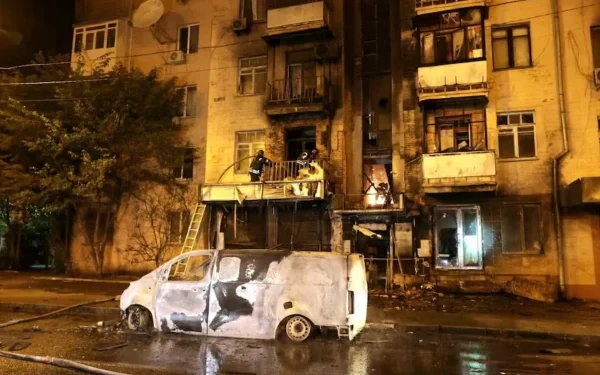In yet another escalation of the ongoing conflict, Russian drone strikes struck Ukraine’s northeastern city of Kharkiv early Friday morning, injuring at least 50 people and causing extensive damage to civilian infrastructure. Among the injured was an 11-year-old girl, highlighting the tragic toll the war continues to take on innocent civilians.
Russian Drone Assault: A New Wave of Violence in Kharkiv
According to reports from international media and local Ukrainian officials, the drone attack targeted densely populated residential areas and civilian infrastructure, sparking widespread panic and destruction. The strikes, which took place before dawn, led to fires in several districts of Kharkiv. Emergency services were quickly dispatched, and rescue operations began almost immediately.
Kharkiv regional governor Oleh Syniehubov confirmed the incident in a public statement, detailing that multiple buildings and vehicles were destroyed in the strikes. He also stated that some of the injured were in critical condition and had been admitted to various hospitals across the city.
“These were deliberate strikes on civilians,” said Syniehubov. “Residential buildings, a school, and a medical facility were hit. This is yet another war crime by the Russian Federation.”
Civilian Infrastructure Targeted
Images and videos circulating on Ukrainian social media platforms show smoldering buildings, crushed vehicles, and frantic citizens fleeing the scenes. According to Ukraine’s State Emergency Service, the affected areas included apartment complexes and public service buildings. Local utility lines were also damaged, resulting in temporary outages of electricity and water in some neighborhoods.
Several residents reported that the attack came without warning, unlike many previous air raid alerts. “There was no time to get to the shelter,” said one survivor. “Everything exploded suddenly. It felt like the entire building was shaking.”
The attack has reignited concerns about the use of drones in urban warfare, especially given the increasingly precise yet destructive capabilities of Russian-made Shahed-type drones, believed to be based on Iranian designs.
A Strategic City Under Constant Fire
Kharkiv, Ukraine’s second-largest city, lies just 40 kilometers from the Russian border and has been a primary target since the early days of the full-scale Russian invasion in February 2022. The city, known for its industrial base and cultural significance, has been subjected to relentless shelling, airstrikes, and drone attacks for over two years.
Despite suffering extensive damage in the early months of the war, Kharkiv has remained under Ukrainian control and become a symbol of Ukrainian resistance. Local authorities have worked tirelessly to maintain some level of normalcy in the city, but recent attacks are further eroding already strained infrastructure and morale.
U.S.-Ukraine Mineral Agreement and Timing of the Attack
Friday’s drone strike comes on the heels of a strategic agreement between Ukraine and the United States concerning the exploration and development of critical mineral resources within Ukrainian territory. According to analysts, Russia’s intensified military aggression may be a direct response to this new cooperation, which could strengthen Ukraine’s economic independence and strategic partnerships.
The mineral deal is seen as part of a broader Western strategy to reduce reliance on Russian energy and resources while bolstering Ukraine’s economy amidst ongoing conflict. While the specific terms of the agreement remain confidential, it is believed to include U.S. investment in Ukraine’s lithium, rare earth metals, and other key resources.
Humanitarian Impact and Rising Civilian Casualties
The humanitarian toll of the war continues to rise as civilians bear the brunt of increasing hostilities. According to the United Nations Office for the Coordination of Humanitarian Affairs (OCHA), over 9,000 civilians have been killed since the start of the war, with tens of thousands injured. Many of these casualties have resulted from indiscriminate attacks on civilian-populated areas such as Kharkiv, Mariupol, and Odesa.
International humanitarian organizations have repeatedly condemned Russia’s tactics, calling them violations of international law and potential war crimes under the Geneva Conventions. The International Criminal Court (ICC) has already issued arrest warrants for Russian officials in connection with alleged atrocities in Ukraine.
International Reactions and Diplomatic Responses
In response to the latest drone strikes, the United States reiterated its support for Ukraine and condemned the targeting of civilians. A statement from the U.S. State Department called the attack “a blatant violation of international law and an escalation that undermines efforts to negotiate peace.”
White House National Security Advisor Jake Sullivan reaffirmed that the U.S. would continue supplying Ukraine with air defense systems, including additional Patriot missile batteries and counter-drone technology.
Meanwhile, the European Union also expressed outrage over the Kharkiv attacks, urging the international community to step up pressure on Russia through additional sanctions and diplomatic isolation.
Peace Talks and the Road Ahead
While the United States has said that it is in ongoing communication with both Russia and Ukraine to find a path toward de-escalation, officials admit that meaningful progress has been difficult. The recent intensification of Russian strikes, including those in Kharkiv, Bakhmut, and Zaporizhzhia, suggests that Moscow is not currently interested in entering into negotiations from a position of compromise.
Ukrainian President Volodymyr Zelenskyy has maintained that any peace talks must include the full restoration of Ukraine’s territorial integrity and accountability for war crimes. Russia, on the other hand, continues to demand recognition of its annexation of Crimea and other occupied territories, conditions that remain unacceptable to Kyiv and its allies.
Kharkiv Residents Struggle to Cope
The psychological toll of the war is mounting for Kharkiv residents, many of whom have spent months in underground shelters or relocated to other parts of the country. Mental health experts working with aid organizations report rising rates of trauma, depression, and anxiety—particularly among children and the elderly.
Local NGOs and international partners like the Red Cross and Médecins Sans Frontières (Doctors Without Borders) are providing emergency medical aid, trauma care, and temporary housing, but the resources are often stretched thin.
“We are trying our best to cope,” said a Kharkiv schoolteacher who now volunteers at a local aid center. “But every new attack makes it harder to stay hopeful. Still, we don’t want to leave our city. This is our home.”
Conclusion: A Grim Reminder of War’s Costs
The drone attack on Kharkiv is a stark reminder of the ongoing humanitarian crisis unfolding in Ukraine and the urgency with which the international community must act. As geopolitical tensions escalate and diplomatic efforts stall, civilians continue to suffer on the frontlines of a brutal and protracted war.
While Ukraine remains defiant and committed to resisting aggression, the continued targeting of civilian infrastructure by Russian forces makes peace an increasingly elusive goal. The world watches as cities like Kharkiv endure, hoping that renewed international efforts can eventually bring an end to the violence.

























